【手撕LLM - Mixtral-8x7B】Pytorch 实现
2. Mixtral 8x7B Model Architecture and Computational Flow
2.2 SMoE Layer Implementation 2.2.1 Single Expert Implementation
2.4.2 Mixtral Load Balance Loss Calculation Process
5. Mixtral 8x7B Summary & Further Reading
I am Xiaodonggua AIGC, sharing original long-form articles with knowledge that has helped multiple students quickly succeed in the LLM track
Research direction: LLM, RLHF, Safety, Alignment
0. Preface
This article discusses the implementation of the mixture of experts in Mixtral 8x7B from a code perspective. It is recommended to read sMoE in advance
1. Paper Overview

Mixtral of Experts mistral-AI
Mixtral-8x7B has sparked the technical direction of MoE, leading to the emergence of more MoE-optimized Trick. This article focuses on the model itself to provide an analysis:
Mixtral 8x7Badopts thesMoEmodel architecture. How are the details of the model? How is the routing load balancing calculated? How is the code implemented?Mixtral 8x7B的训练流程和推理流程是怎样的,如何提高训练和推理的效率?Mixtral 8x7B的 model parameters are calculated in what way?Mixtral 8x7Bperformance rivalsLLaMA2-70BandGPT-3.5, reaching top-tier standards, and inMBPPcode capabilities surpass3.5.

2. Mixtral 8x7B Model Architecture and Computational Flow
Mixtral is based on a transformer architecture [31] and uses the same modifications as described in [18], with the notable exceptions that Mixtral supports a fully dense context length of 32k tokens, and the feed forward blocks are replaced by Mixture-of-Expert layers (Section 2.1). The model architecture parameters are summarized in Table 1.
base的模型结构为Transformers的改版Mistral-7BThe model structure ofbaseis a modified version ofTransformers, specificallyMistral-7BMoEis applied toFeed Forward Blocks
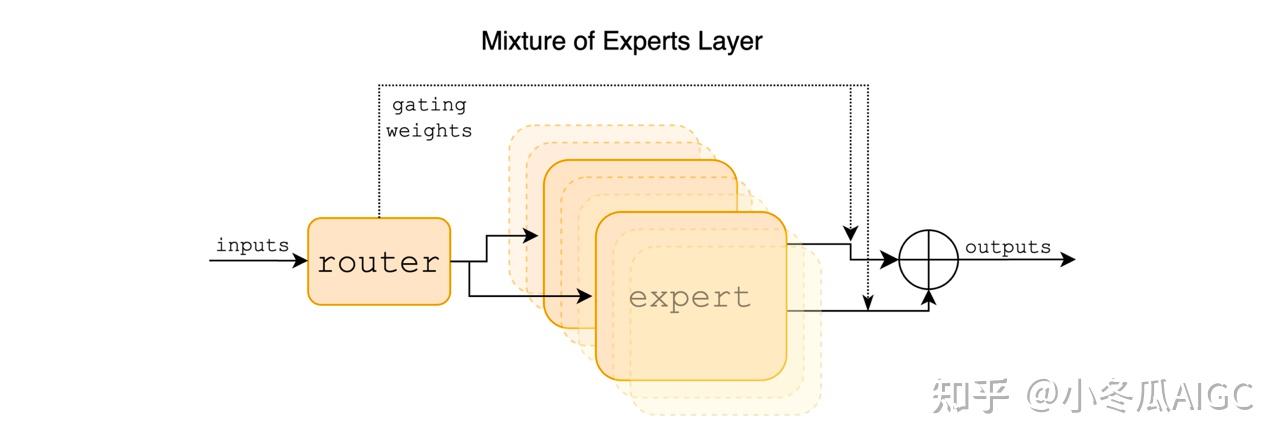
2.1 Model Architecture
In a Transformer model, the MoE layer is applied independently per token and replaces the feed-forward (FFN) sub-block of the transformer block. For Mixtral we use the same SwiGLU architecture as the expert function Ei(x) and set K = 2. This means each token is routed to two SwiGLU sub-blocks with different sets of weights. Taking this all together, the output y for an input token x is computed as:
y=\sum^{n-1}_{i=0}\text{Softmax}(\text{Top2}(x \cdot W_g))_i \cdot \text{SwiGLU}_i(x)
ForLLaMA2orMistral-7B, theirMLPis in the form ofSwiGLU
InMixtral-8x7B, theDecoderlayer of each layer replaces theMLPwithsMoE
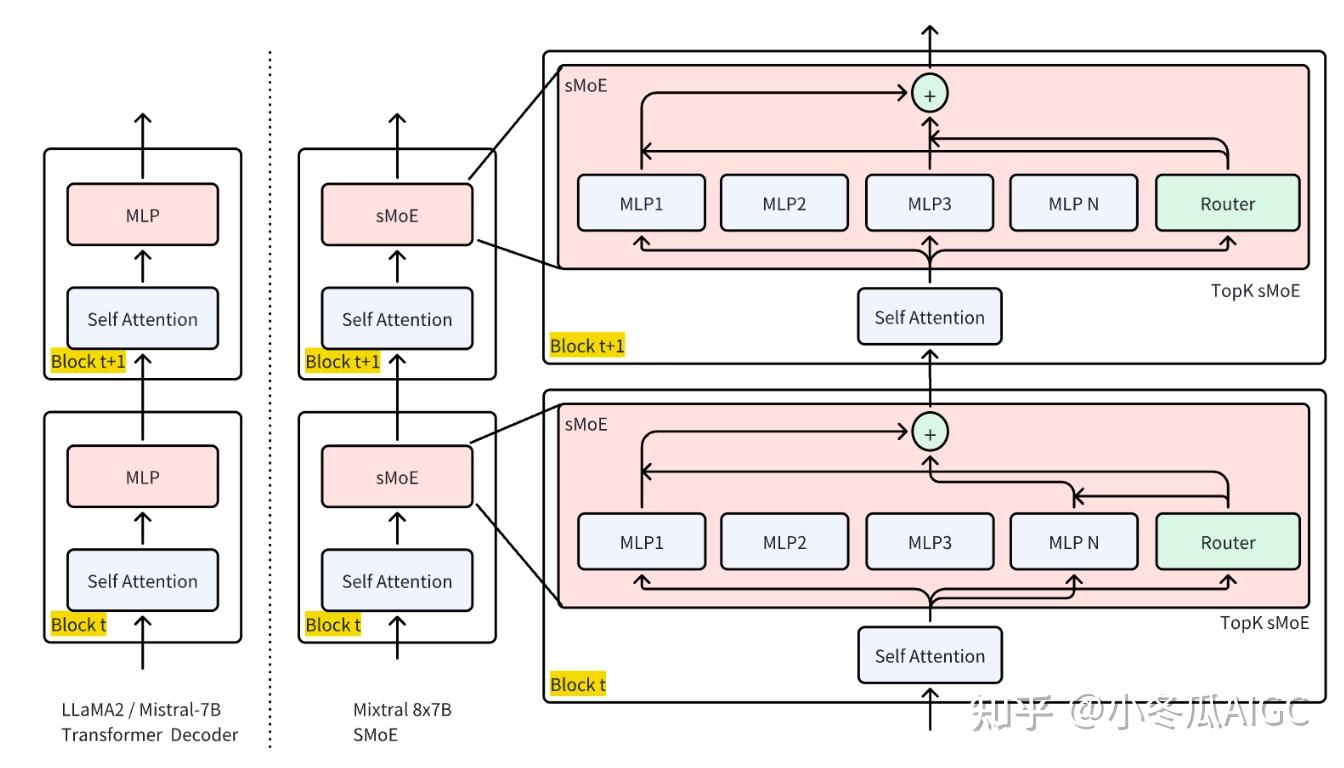
Transformers Mixtral-of-Expert 代码实现:
In the Huggingface Transformers framework, Mixtral mainly consists of two parts
MixtralDecoderLayerMixtralSparseMoeBlock:Replace the originalMLPlayer
from transformers import AutoModelForCausalLM, AutoTokenizer, AutoConfig
import torch
import torch.nn.functional as F
model_id = "mistralai/Mixtral-8x7B-Instruct-v0.1"
# 创建小模型用于调试
config = AutoConfig.from_pretrained(model_id)
config.num_hidden_layers = 2
config.num_attention_heads = 8
config.hidden_size = 128
config.intermediate_size = 256
config.intermediate_size = config.hidden_size*2
config.num_experts_per_tok = 2 # Top-2 专家数量
config.num_local_experts = 8 # 专家总数量
# print(config)
model = AutoModelForCausalLM.from_config(config)
print(model)Output result
MixtralForCausalLM(
(model): MixtralModel(
(embed_tokens): Embedding(32000, 128)
(layers): ModuleList(
(1): MixtralDecoderLayer(
(self_attn): MixtralAttention(
(q_proj): Linear(in_features=128, out_features=128, bias=False)
(k_proj): Linear(in_features=128, out_features=128, bias=False)
(v_proj): Linear(in_features=128, out_features=128, bias=False)
(o_proj): Linear(in_features=128, out_features=128, bias=False)
(rotary_emb): MixtralRotaryEmbedding()
)
(block_sparse_moe): MixtralSparseMoeBlock(
(gate): Linear(in_features=128, out_features=8, bias=False)
(experts): ModuleList(
(0-7): 8 x MixtralBLockSparseTop2MLP(
(w1): Linear(in_features=128, out_features=256, bias=False)
(w2): Linear(in_features=256, out_features=128, bias=False)
(w3): Linear(in_features=128, out_features=256, bias=False)
(act_fn): SiLU()
)
)
)
(input_layernorm): MixtralRMSNorm()
(post_attention_layernorm): MixtralRMSNorm()
)
)
(norm): MixtralRMSNorm()
)
2.2 SMoE Layer Implementation
2.2.1 Single Expert Implementation
import torch
from torch import nn
from transformers import MixtralConfig
class MixtralBLockSparseTop2MLP(nn.Module):
def __init__(self, config: MixtralConfig):
super().__init__()
self.ffn_dim = config.intermediate_size
self.hidden_dim = config.hidden_size
self.w1 = nn.Linear(self.hidden_dim, self.ffn_dim, bias=False)
self.w2 = nn.Linear(self.ffn_dim, self.hidden_dim, bias=False)
self.w3 = nn.Linear(self.hidden_dim, self.ffn_dim, bias=False)
self.act_fn = nn.SiLU()
# Forward 是 SwiGLU
def forward(self, hidden_states):
y = self.act_fn(self.w1(hidden_states)) * self.w3(hidden_states)
y = self.w2(y)
return y
x = torch.randn(1, 64, 128)
expert = MixtralBLockSparseTop2MLP(config)
print('单个专家为原LLaMA的MLP层')
print(expert)
g = expert(x)
print('单个专家输入:', x.shape)
print('单个专家输出结果:', g.shape)
Result
单个专家为原LLaMA的MLP层
MixtralBLockSparseTop2MLP(
(w1): Linear(in_features=128, out_features=256, bias=False)
(w2): Linear(in_features=256, out_features=128, bias=False)
(w3): Linear(in_features=128, out_features=256, bias=False)
(act_fn): SiLU()
)
单个专家输入:
torch.Size([1, 64, 128])
单个专家输出结果:
torch.Size([1, 64, 128])2.2.2 Hybrid Expert Implementation
class MixtralSparseMoeBlock(nn.Module):
def __init__(self, config):
super().__init__()
self.hidden_dim = config.hidden_size
self.ffn_dim = config.intermediate_size
self.num_experts = config.num_local_experts
self.top_k = config.num_experts_per_tok
# gating
self.gate = nn.Linear(self.hidden_dim, self.num_experts, bias=False)
# 多个 SwiGLU MLP 层组成混合专家
self.experts = nn.ModuleList([MixtralBLockSparseTop2MLP(config) \
for _ in range(self.num_experts)])
x = torch.randn(1, 64, 128)
experts = MixtralSparseMoeBlock(config)
print('多个专家混合专家')
print(experts)Result:
多个专家混合专家
MixtralSparseMoeBlock(
(gate): Linear(in_features=128, out_features=8, bias=False)
(experts): ModuleList(
(0-7): 8 x MixtralBLockSparseTop2MLP(
(w1): Linear(in_features=128, out_features=256, bias=False)
(w2): Linear(in_features=256, out_features=128, bias=False)
(w3): Linear(in_features=128, out_features=256, bias=False)
(act_fn): SiLU()
)
)
)
In the above, we have implemented the key structure of the model, but the sMoE Forward has not been implemented
2.3 SMoE Calculation Process
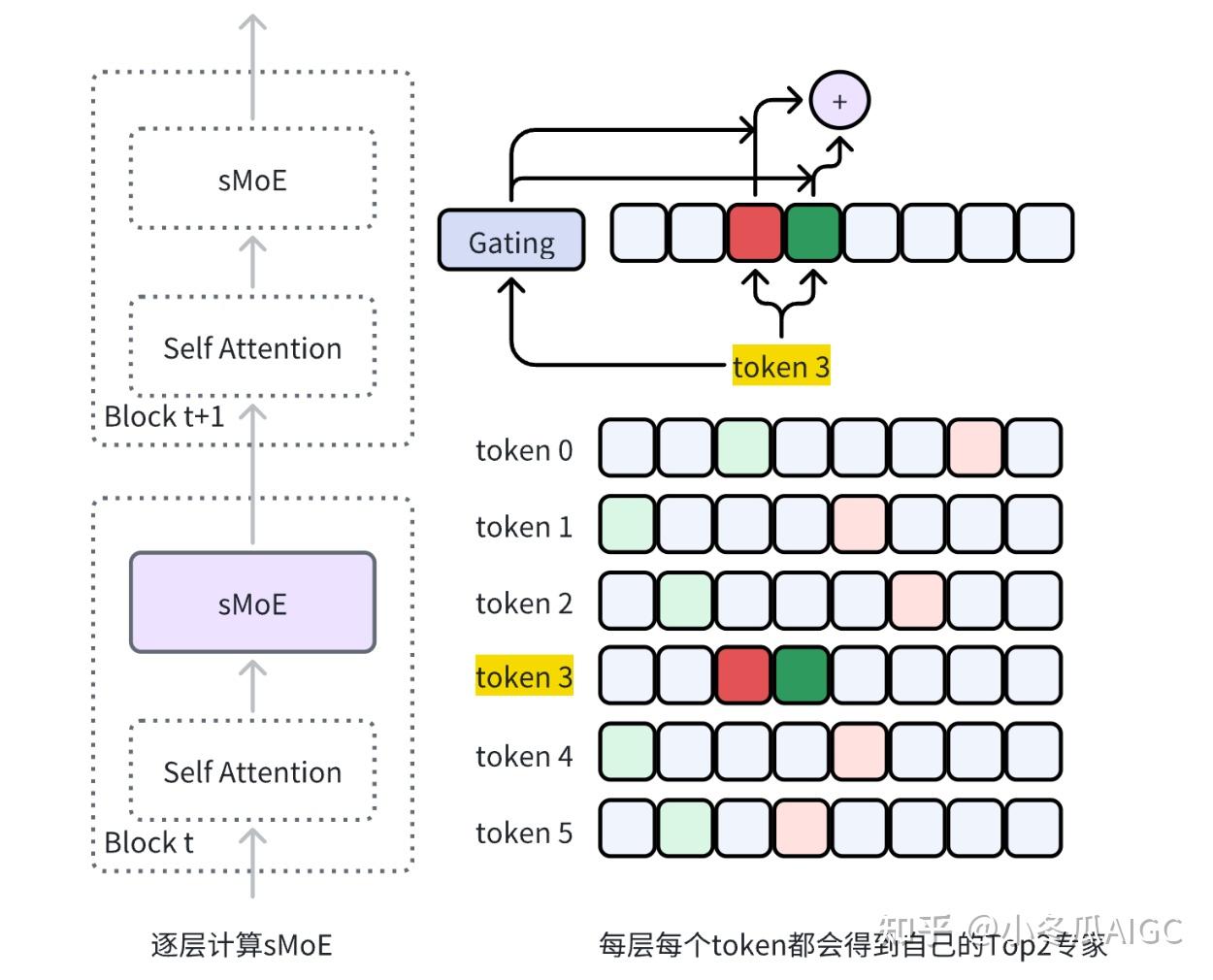
2.3.1 Gating process
The following represents the computation process for multiple token gating
# 阶段一
# 计算稀疏 gating 值
tokens = 6
x = torch.randn(1, tokens, 128) # 6个token
hidden_states = x
batch_size, sequence_length, hidden_dim = hidden_states.shape
hidden_states = hidden_states.view(-1, hidden_dim)
# 每层都会产生router_logits, 将用于最后作 load balance loss
router_logits = experts.gate(hidden_states)
print(f'experts.gate output router logits : \n {router_logits}')
# 计算 TopK 的 专家 logits 和 Top2 专家的位置
routing_weights = F.softmax(router_logits, dim=1, dtype=torch.float)
print(f'softmax weight : \n {routing_weights}')
routing_weights, selected_experts = torch.topk(routing_weights, \
experts.top_k, dim=-1)
print(f'expert select : \n {selected_experts}')
print(f'topk : \n {routing_weights}')
routing_weights /= routing_weights.sum(dim=-1, keepdim=True)
print(f'topk归一化 : \n {routing_weights}')
routing_weights = routing_weights.to(hidden_states.dtype)
## One Hot 编码
expert_mask = torch.nn.functional.one_hot(selected_experts, \
num_classes=experts.num_experts).permute(2, 1, 0)
for i in range(tokens):
print(f'【token_{i}】\n', expert_mask[:,:,i]) 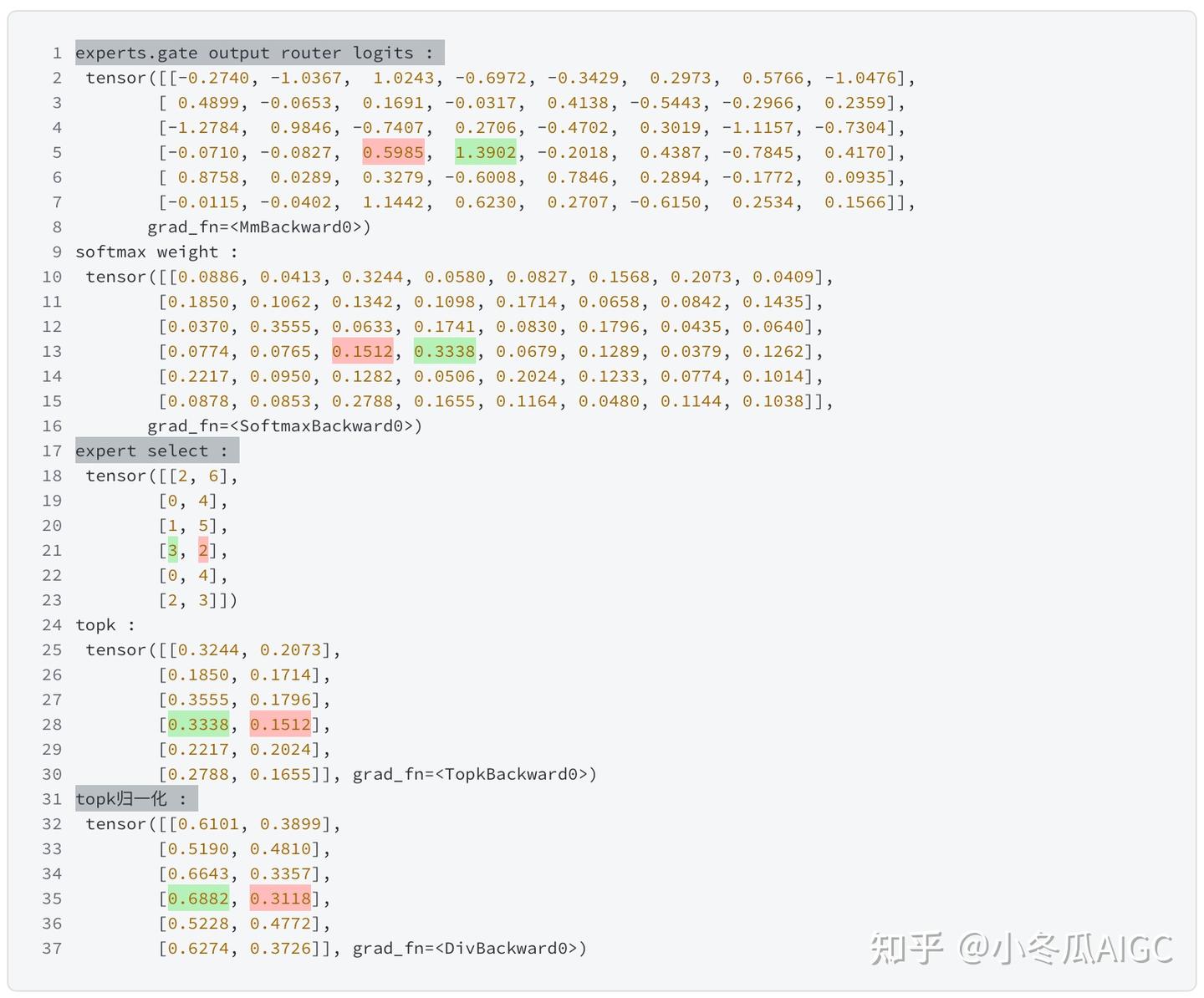
追踪x3的结果

2.3.2 Expert process
y = \sum ^{n-1}_{i=0}\text{Softmax}(\text{Top2}(x\cdot W_g))_i \cdot \text{SwiGLU}_i(x)
sMoEis based on selectingtokenfor computationtokenPre-order: The left figure selectstoken3forexpert 2andexpert 3to compute thesMoEresultexpertPre-order: The result ofsMoEis obtained by sequentially calculatingexpert2andexpert3to gettoken3
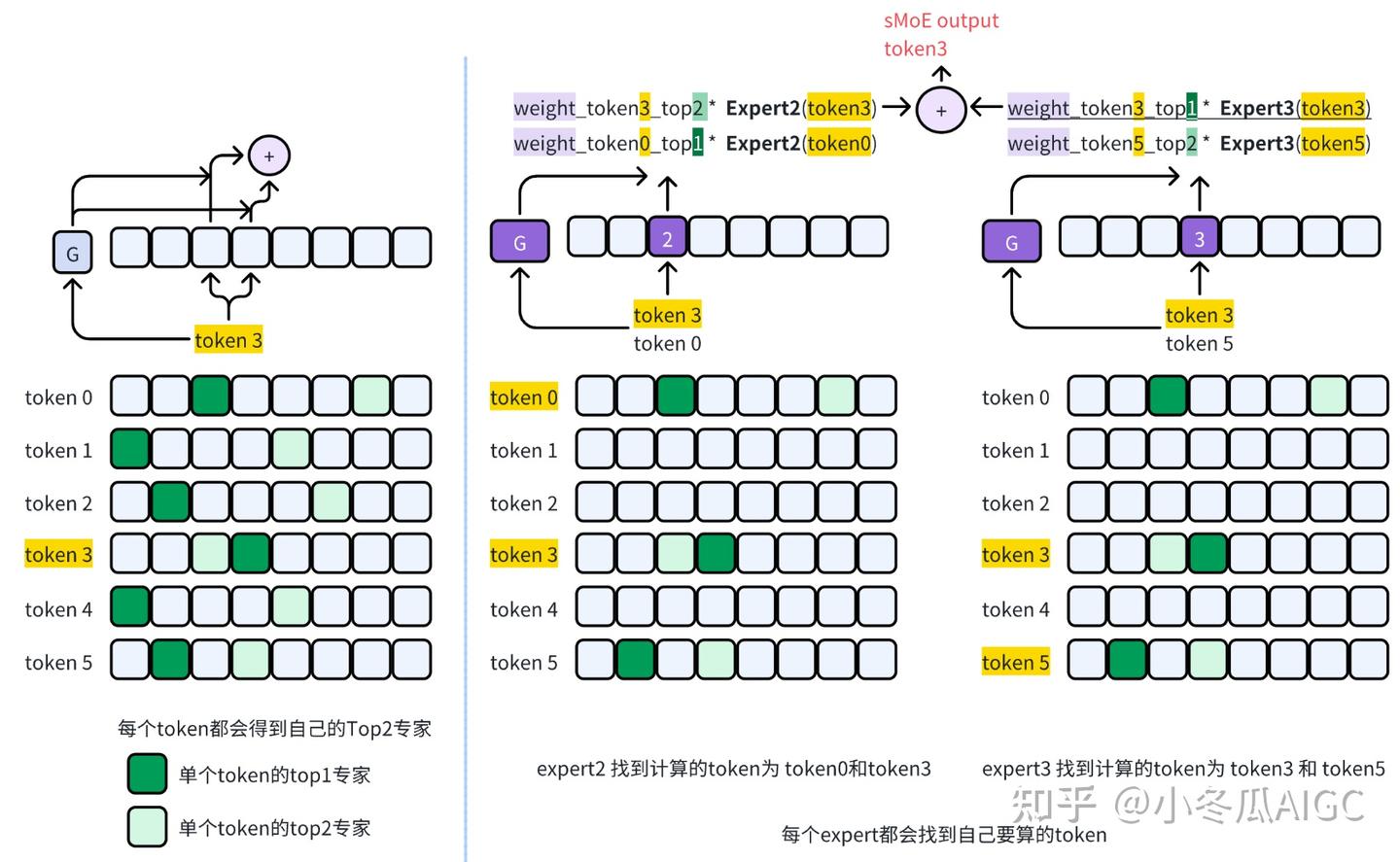
The implementation result of the code is:
## 最终结果
final_hidden_states = torch.zeros(
(batch_size * sequence_length, hidden_dim), \
dtype=hidden_states.dtype, device=hidden_states.device
)
print(f'final moe result shape for each token: {final_hidden_states.shape}')
# 每个专家收集需要计算token
for expert_idx in range(experts.num_experts):
print(f'--------expert {expert_idx} ---------')
expert_layer = experts.experts[expert_idx]
print(expert_mask[expert_idx])
idx, top_x = torch.where(expert_mask[expert_idx])
print(f'专家 {expert_idx} 计算的样本编号:',top_x.tolist()) # select x_idx for expert top1
print(f'专家 {expert_idx} top1:0, top2:1 ',idx.tolist()) # 0 is top1 ,1 is top2
print(f'有 {len(top_x)} / {x.shape[1]} token 选到专家 {expert_idx}')
top_x_list = top_x.tolist()
idx_list = idx.tolist()
current_state = hidden_states[None, top_x_list].reshape(-1, hidden_dim)
# expert_0(x) * routing_weights
current_hidden_states = expert_layer(current_state) \
* routing_weights[top_x_list, idx_list, None]
# 将计算的单个专家结果填入到结果表里
final_hidden_states.index_add_(0, top_x, current_hidden_states.to(hidden_states.dtype))
print(current_state.shape)
print(routing_weights[top_x_list, idx_list, None].shape)
print(current_hidden_states.shape)
print(final_hidden_states.shape)
# if expert_idx == 1: breakThe output result is
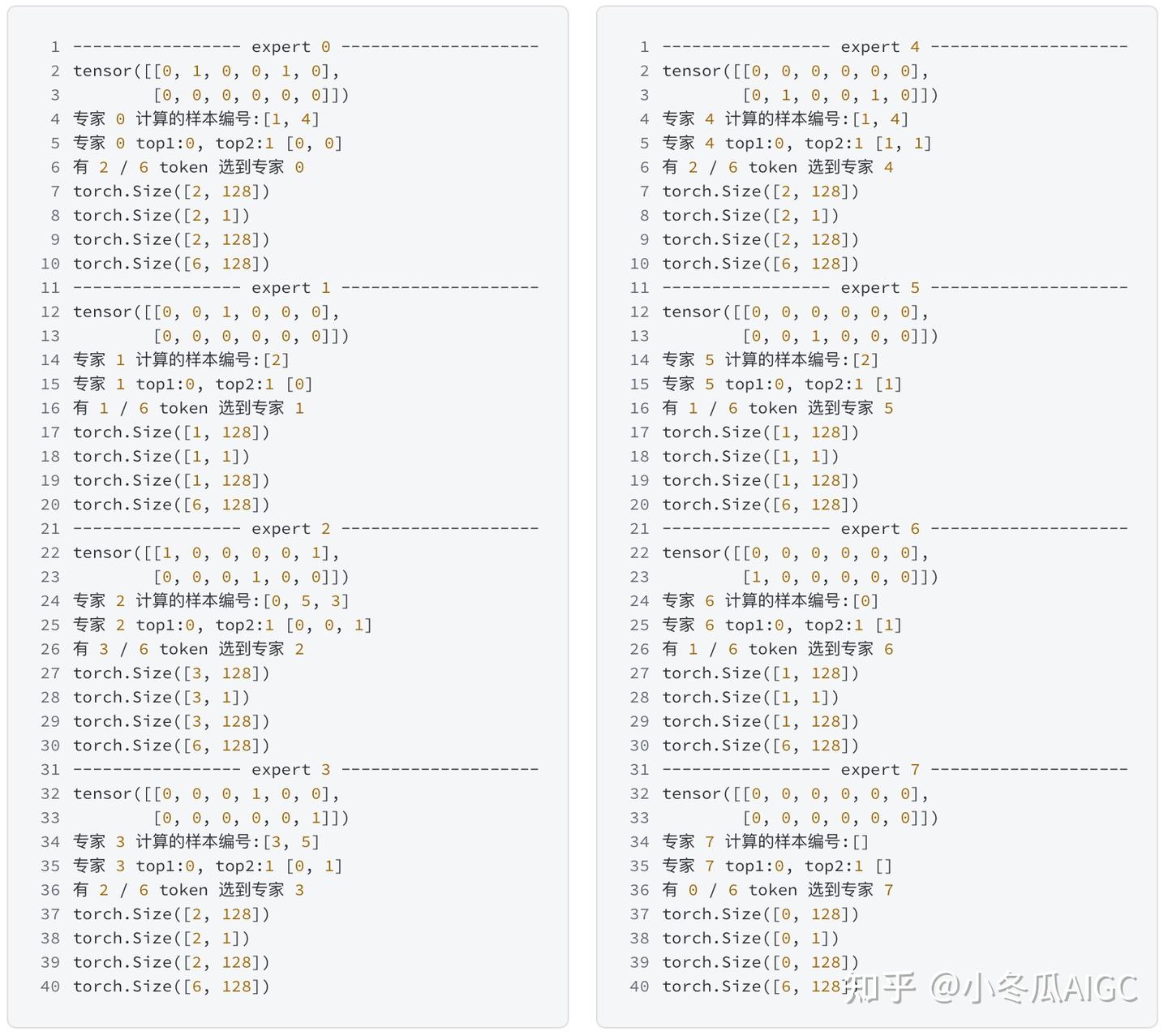
2.4 Router Load Balence 计算
The implementation of routing load balancing comes from Switch Transformers
Computes auxiliary load balancing loss as in Switch Transformer - implemented in Pytorch. See Switch Transformer for more details. This function implements the loss function presented in equations (4) - (6) of the paper. It aims at penalizing cases where the routing between experts is too unbalanced.
2.4.1 Switch Transformers Load Balance Loss
This algorithm is a simplified version of sMoE, removing the original estimation of balance loss calculation in load balance balance
loss = \alpha\cdot N\cdot \sum ^N_{i=1}f_i\cdot P_i
f_i = \frac{1}{T}\sum_{x\in\mathcal{B}}\mathbb{1}\{\text{argmax }p(x)=i\}
fi: the probability of the number of tokens assigned to the i-th expert in a batch
P_i=\frac{1}{T}\sum_{x\in \mathcal{B}}p_i(x)
Pi: In a batch of T tokens, the probability of each expert selecting the tokens and
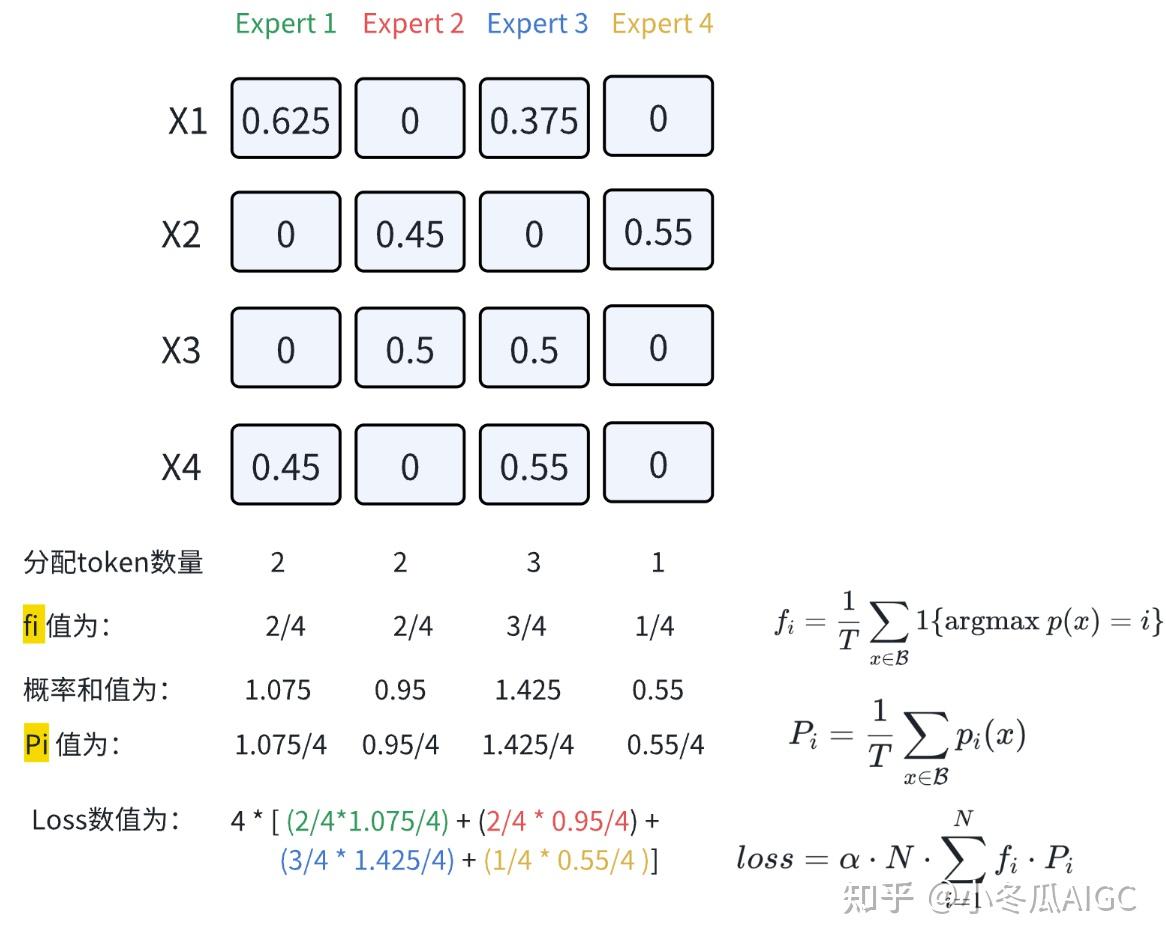
2.4.2 Mixtral Load Balance Loss Calculation Process
You can imagine that layer norm is just applied to all tokens within the current layer, while load balancing is handled over a broader scope, calculating the single expert load for all tokens across all layers, and summing these values to obtain the overall load balancing loss for the network
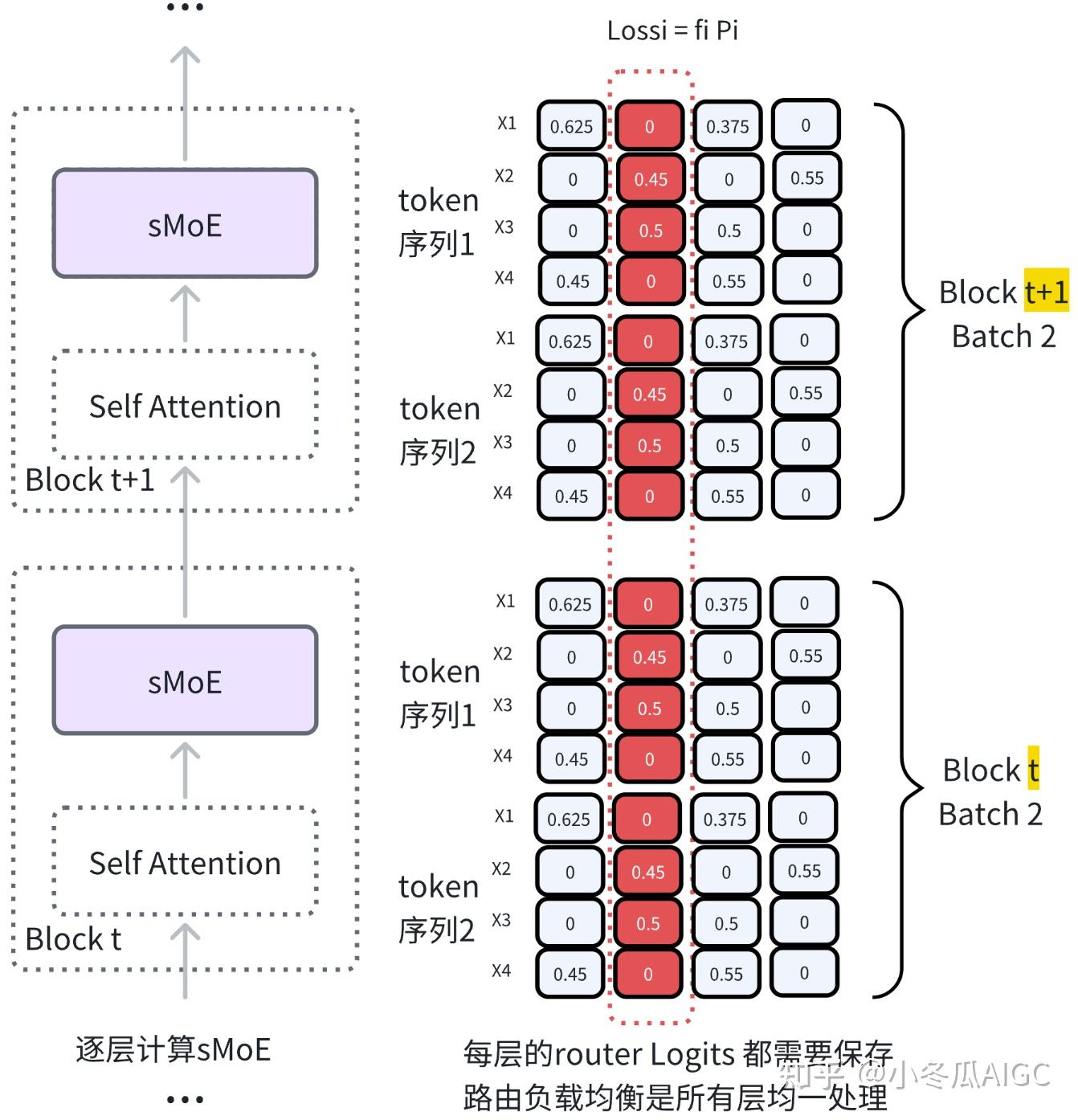
2.4.3 Manual Load Balancing
import torch
num_experts = 8
batch = 10
seq_length = 6
top_k = 2
print(f'sMoE num_experts:{num_experts} top_k:{top_k} batch:{batch} seq_length:{seq_length}')
router_logits_1 = torch.randn(batch, seq_length, num_experts).view(-1,num_experts) # layer 1
router_logits_2 = torch.randn(batch, seq_length, num_experts).view(-1,num_experts) # layer 2
router_logits = [router_logits_1, router_logits_2]
concatenated_gate_logits = torch.cat(router_logits, dim = 0)
print('单层gating的路由logits:', router_logits_1.shape)
print('两层gating的路由logits:', concatenated_gate_logits.shape)
print('根据logits top-k 计算热独编码')
routing_weights = torch.nn.functional.softmax(concatenated_gate_logits, dim=-1)
_, selected_experts = torch.topk(routing_weights, top_k, dim=-1)
expert_mask = torch.nn.functional.one_hot(selected_experts, num_experts)
print(expert_mask.shape)
tokens_sum_expert = torch.sum(expert_mask.float(), dim=0)
tokens_per_expert = torch.mean(expert_mask.float(), dim=0)
print(f'top1 每个专家平均处理的token :', tokens_sum_expert[0])
print(f'top2 每个专家平均处理的token fi:', tokens_per_expert[1])
print(f'top1与top2水平合计', tokens_per_expert.sum(dim=1))
# Compute the average probability of routing to these experts
router_prob_per_expert = torch.mean(routing_weights, dim=0)
print('router_prob_per_expert Pi: ' , router_prob_per_expert)
print( '每个专家的负载:', tokens_per_expert * router_prob_per_expert.unsqueeze(0))
overall_loss = torch.sum(tokens_per_expert * router_prob_per_expert.unsqueeze(0))
print('final loss:', overall_loss)
The settlement result is:
sMoE num_experts:8 top_k:2 batch:10 seq_length:6
单层gating的路由logits:
torch.Size([60, 8])
两层gating的路由logits:
torch.Size([120, 8])
根据logits top-k 计算热独编码
torch.Size([120, 2, 8])
top1 每个专家平均处理的token : tensor([10., 14., 19., 17., 14., 9., 17., 20.])
top2 每个专家平均处理的token fi: tensor([0.1667, 0.1333, 0.1833, 0.0833, 0.1167, 0.1500, 0.0667, 0.1000])
top1与top2水平合计 tensor([1., 1.])
router_prob_per_expert Pi: tensor([0.1236, 0.1184, 0.1351, 0.1168, 0.1311, 0.1147, 0.1156, 0.1447])
每个专家的负载: tensor([[0.0103, 0.0138, 0.0214, 0.0165, 0.0153, 0.0086, 0.0164, 0.0241],
[0.0206, 0.0158, 0.0248, 0.0097, 0.0153, 0.0172, 0.0077, 0.0145]])
final loss: tensor(0.2520)
The gating logits are cross-batch and cross-layer, acting on each token in every layer
3. Mixtral 8x7B parameter calculation
3.1 Original paper description
The 13B refers to the number of model parameters involved in a single token. During actual inference, each token has different experts, so the actual operation still runs with 47B parameters. Using sMoE does not reduce the memory usage.
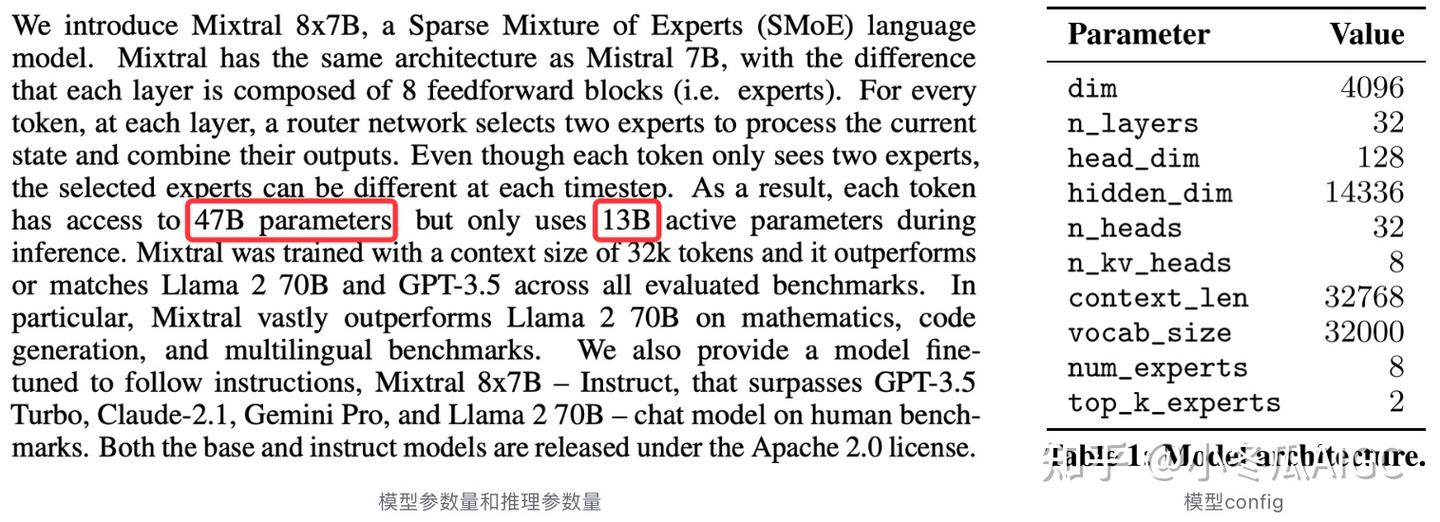
3.2 Model parameter calculation
Ignore GQA calculation
dim = 4096
n_layers = 32
head_dim = 128
hidden_dim = 14336
n_heads = 32
n_kv_heads = 8 # ignore GQA
vocab_size = 32000
num_experts = 8
top_k_experts = 2
# attention mlp layernorm
llama_num = n_layers * (dim * dim * 4 + hidden_dim * dim * 3 + 2 * dim ) \
+ 2 * vocab_size * dim
print('llama:', llama_num)
# attention 【mlp*8】 layernorm
moe_num = n_layers * (dim * dim * 4 + hidden_dim * dim * 3 * 8 + 2 * dim ) \
+ 2 * vocab_size * dim
print('moe:', moe_num)
# attention 【mlp*2】 layernorm
# ToP2-inference
moe_num = n_layers * (dim * dim * 4 + hidden_dim * dim * 3 * 2 + 2 * dim ) \
+ 2 * vocab_size * dim
print('moe top2:', moe_num)Parameter results
llama: 8047034368
moe: 47507046400
moe inference: 136841789444. MoE extension
4.1 MegaBlocks
MoE layers can be run efficiently on single GPUs with high performance specialized kernels. For example, MegablocksMegaBlocks implements sparse MoE computation

By the way, XFormers also implements operators with similar ideas, where batch attention is achieved through Mask to realize sparse computation across multiple sequences.

4.2 GShard
Mixtral is mentioned in the paper under load balance, referring to GShard, the first work to introduce MoE into Transformers
This formulation is similar to the GShard architecture [21], with the exceptions that we replace all FFN sub-blocks by MoE layers while GShard replaces every other block, and that GShard uses a more elaborate gating strategy for the second expert assigned to each token.
GShard allocates different experts on different GPUs, while other parameters are shared. Data is dispatched to the experts, and the aggregation of expert results is achieved by the All-to-All operator
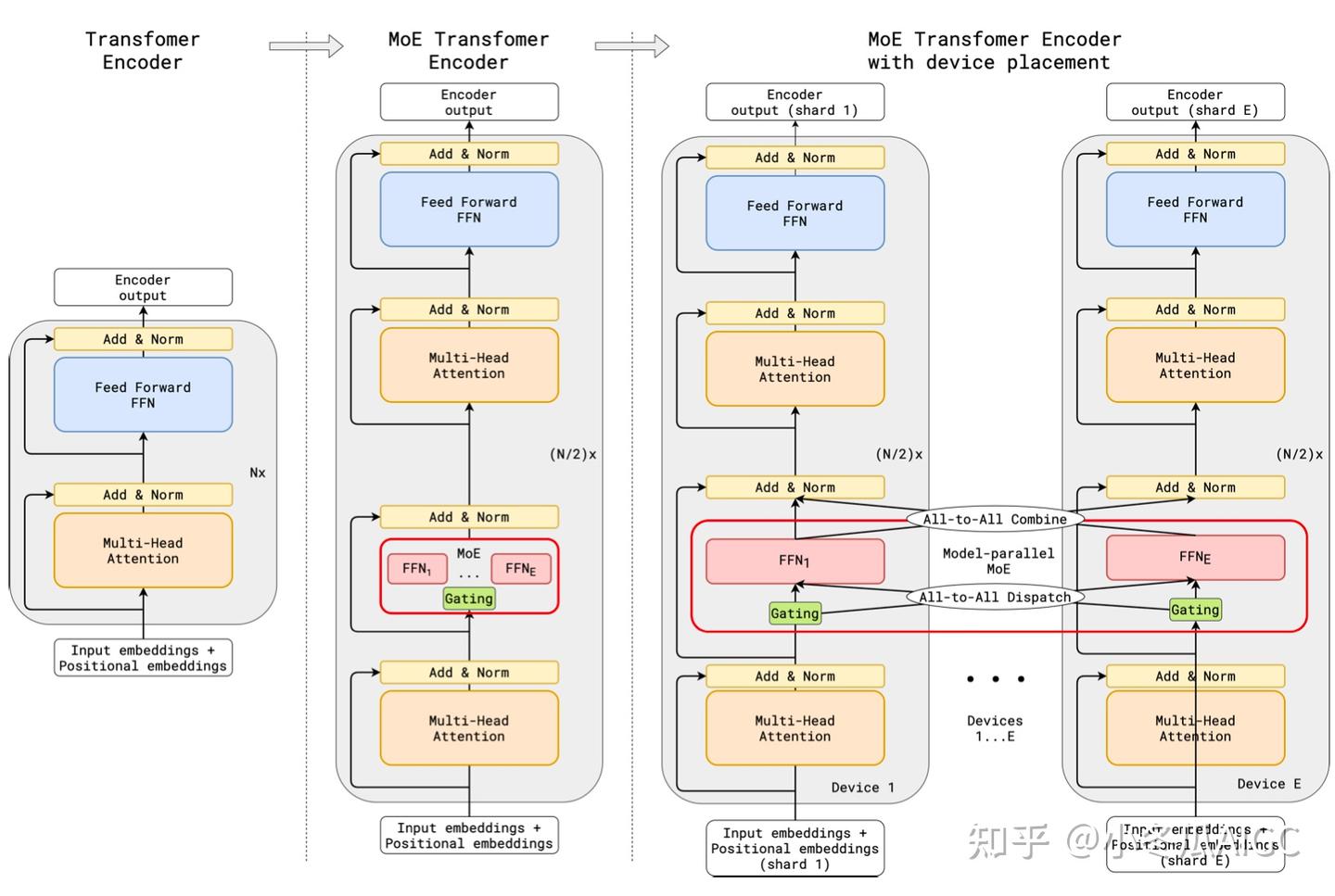
DeepSpeed-MoE source code implements All-to-All as follows
class _AllToAll(torch.autograd.Function):
@staticmethod
def forward(
ctx: Any,
# TODO: replace with DS process group
group: torch.distributed.ProcessGroup,
input: Tensor) -> Tensor: # type: ignore
ctx.group = group
input = input.contiguous()
output = torch.empty_like(input)
dist.all_to_all_single(output, input, group=group)
return output
@staticmethod
def backward(ctx: Any, *grad_output: Tensor) -> Tuple[None, Tensor]:
return (None, _AllToAll.apply(ctx.group, *grad_output))
class MOELayer(Base):
# ...
def forward(self, *input: Tensor, **kwargs: Any) -> Tensor:
# ...
dispatched_input = _AllToAll.apply(self.ep_group, dispatched_input)
# Re-shape after all-to-all: ecm -> gecm
dispatched_input = dispatched_input.reshape(self.ep_size, self.num_local_experts, -1, d_model)
expert_output = self.experts(dispatched_input)
expert_output = _AllToAll.apply(self.ep_group, expert_output)
#...4.3 DeepSpeed-MoE
A more engineering-oriented implementation can be seen in the open-source solution ofDeepSpeed-MoEMoElayer usesExpert-Parallelismfor parallelism, andAlltoAllis implemented as described above
Non-MoElayers useTP+DP
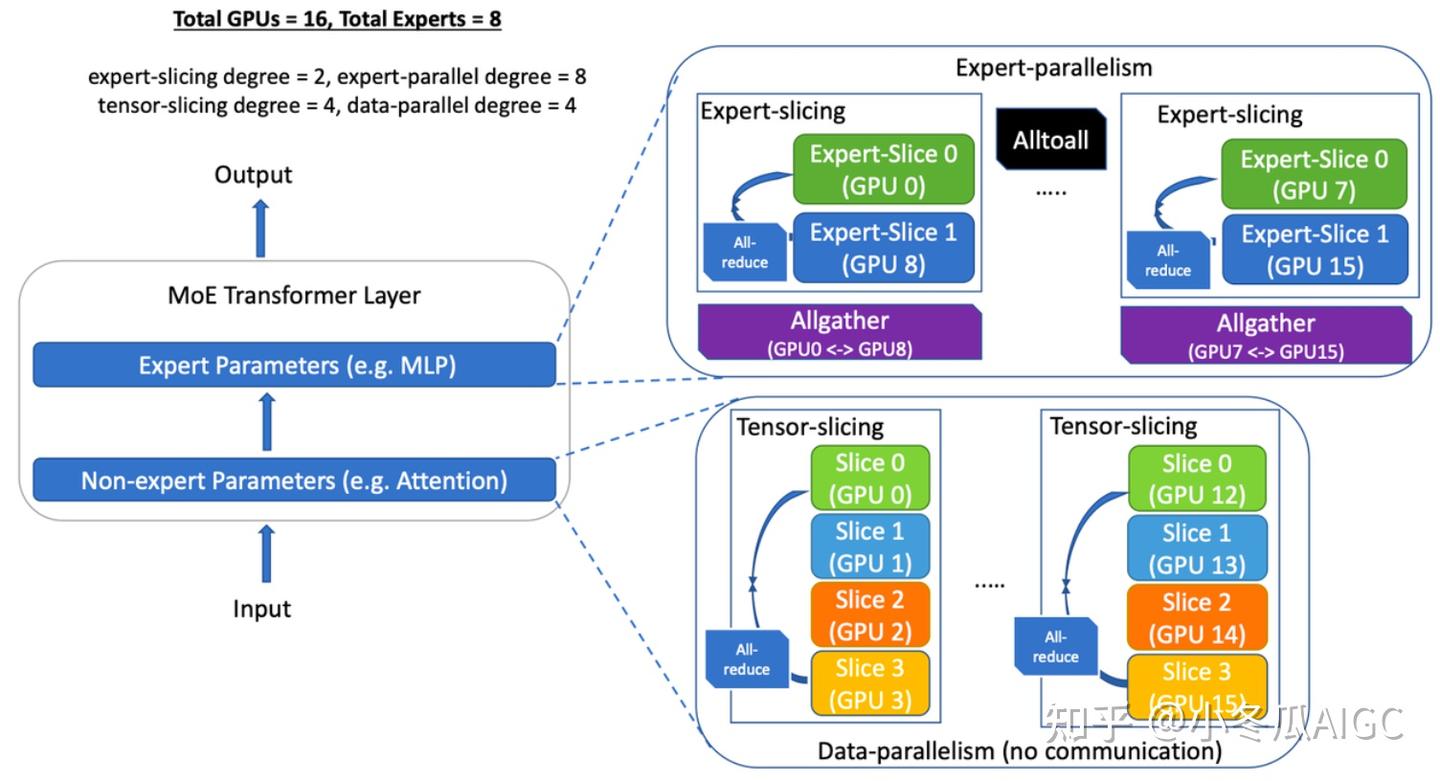
4.4 LLaMA-MoE
Mixtral 8x7B can't be trained? Try converting the original MLP in LLaMA to LLaMA-MoE
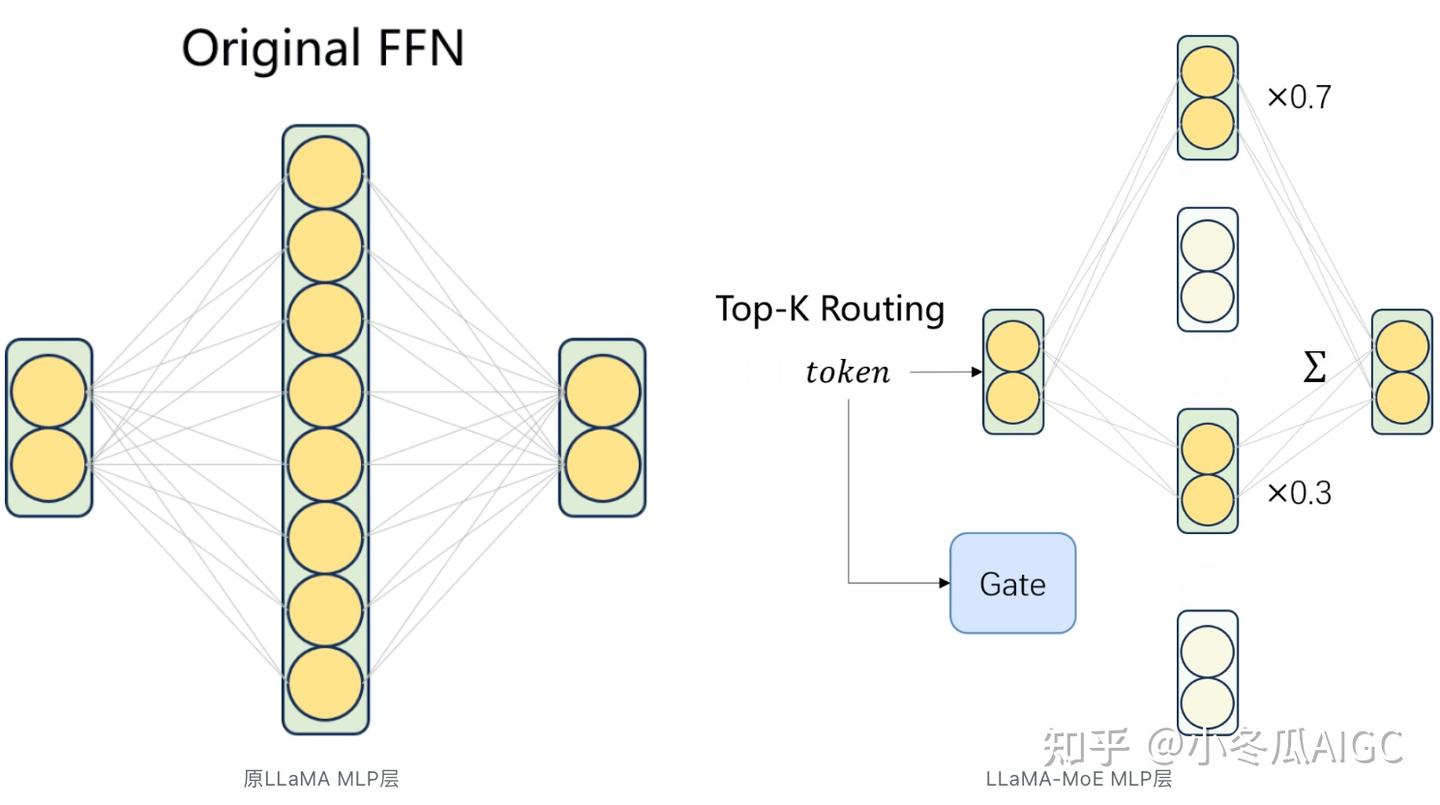
LLaMA-MoE the key code involves replacing the SwiGLU layer in the original LLaMA with LinearGLUExperts
class LinearGLUExperts(nn.Module):
# ...
def __init__(...):
# ...
# 每个专家都创建SwiGLU MLP层
for i in range(num_experts):
# this matrix will be transposed when performing linear forwarding
this_expert_weight_gate = nn.Parameter(
torch.empty((size_experts[i], in_features), **factory_kwargs)
)
# this matrix will be transposed when performing linear forwarding
this_expert_weight_up = nn.Parameter(
torch.empty((size_experts[i], in_features), **factory_kwargs)
)
# this matrix will be transposed when performing linear forwarding
this_expert_weight_down = nn.Parameter(
torch.empty((out_features, size_experts[i]), **factory_kwargs)
)
self.weight_gate.append(this_expert_weight_gate)
self.weight_up.append(this_expert_weight_up)
self.weight_down.append(this_expert_weight_down)
# ...
5. Mixtral 8x7B Summary & Further Reading
Mixtral 8x7Bimplementation is not complicated, where theload-balance lossis calculated on theexpert-wisedimension
The currently released model still focuses on the model architecture, looking forward tomistral.AIlaunching innovative alignment solutions.
Distributed training involving multiple machines and multiple cards forsMoErequires significant engineering skills. Different model architectures and clusters can have various DP\TP\EP... combination schemes. Besides, this series recommendsDeepSpeed.
Fang Jiarui: Interpretation of MoE Training Paper - Megablocks: Breaking the Dynamic Routing Limitations
Fang Jiarui: JANUS: Parameter Server Assisted MoE Training System
Fang Jiarui: Interpretation of MoE Training Paper - Tutel: Achieving Dynamic Routing by Dynamically Switching Parallel Strategies
InMixtral, for the counterintuitive argument in the experiment, the expert's knowledge operates at thetokenlevel, rather than thedomainlevel. If you are interested inMoE, you can further analyze it
Reference
Fang Jiarui: Interpretation of MoE Training Paper - Megablocks: Breaking the Dynamic Routing Limitations
Ximen Yushao: Distributed Acceleration for Training and Inference of MoE Large Models — A Quick Read of the DeepSpeed-MoE Paper
Eating jelly without spitting out the jelly skin: Large Model Distributed Training Parallel Technology (Part 8) - MOE Parallel
Meng Fanxu: Mixtral-8x7B model digging a hole
Mixtral-of-experts
Mistral-7B
Gshard
Switch Transformers
sMoE
Transformers-Mixtral-of-Experts
DeepSpeed-MoE
Megablocks
LLaMA-MoE
Hand-Tearing RLHF explains how to systematically perform LLM alignment engineering
Little Winter Melon AIGC: [Tearing Apart Safe RLHF] PPO Dancing with Shackles on Its Feet
Little Winter Melon AIGC: [Tearing Apart RLHF-LLaMA2] Reward Model PyTorch Implementation
《Tearing Apart LLM》 series of articles + original courses: LLM principles covering Pretrained/PEFT/RLHF/high-performance computing
Little Winter Melon AIGC: 【Tearing Down LLM-Generation】Top-K + Repetition Penalty
"Tearing Apart Agent" explores Agent methods that could lead to AGI from a code and engineering perspective
I am Xiaodonggua AIGC, sharing original long-form articles with knowledge that has helped many students quickly achieve their goals
LLM track Research directions: LLM, RLHF, Safety, Alignment
Edited on 2024-03-08 17:33・IP location Beijing

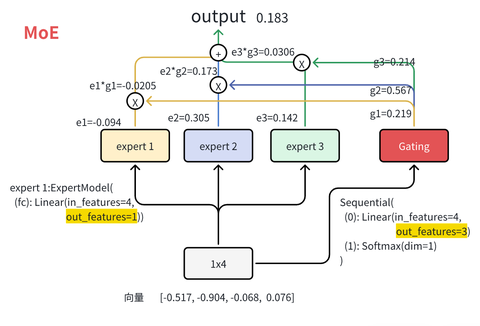


Little Winter Melon tql![[爱]](https://pic1.zhimg.com/v2-0942128ebfe78f000e84339fbb745611.png)
03-16 · Jiangsu
03-19 · Beijing